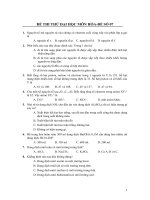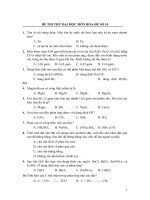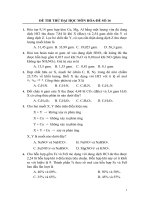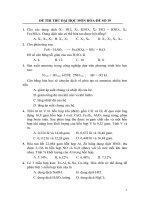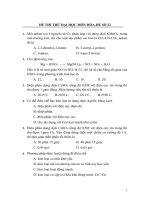Khung ma tran va De tham khao thi TNTHPT 2014
Bạn đang xem bản rút gọn của tài liệu. Xem và tải ngay bản đầy đủ của tài liệu tại đây (175.22 KB, 11 trang )
<span class='text_page_counter'>(1)</span>KHUNG MA TRẬN ĐỀ THI TỐT NGHIỆP CHƯƠNG TRÌNH GDPT CẤP THPT - MÔN TIẾNG ANH (Kết hợp trắc nghiệm khách quan và tự luận) KIẾN THỨC NĂNG LỰC/KỸ NĂNG LANGUAGE FOCUS/ KTNN I: NGỮ ÂM Số câu: 3; Số điểm: 0,75 Tỉ lệ %: 7,5 LANGUAGE FOCUS/ KTNN II: NGỮ PHÁP Số câu: 3; Số điểm: 0,75 Tỉ lệ %: 7,5 LANGUAGE FOCUS/ KTNNIII: TỪ VƯNG Số câu: 4; Số điểm: 1 Tỉ lệ %: 10 LANGUAGE IN USE I SỬ DỤNG NGÔN NGỮ I Số câu: 5; Số điểm: 1,25 Tỉ lệ %: 12,5 LANGUAGE IN USE II SỬ DỤNG NGÔN NGỮ II Số câu: 7; Số điểm: 1,75 Tỉ lệ %: 17,5 READING. Số câu: 8; Số điểm: 2 Tỉ lệ %: 20 WRITING 1. NHẬN BIẾT. THÔNG HIỂU. Nguyên âm và phụ âm (MCQs) Số câu: 2 Số điểm: 0,5 Thì, thể, cách của động từ (MCQs) Số câu: 2 Số điểm: 0,5 Từ vựng trong Chương trình GDPT (MCQs) Số câu: 2 Số điểm: 0,5 Tìm lỗi sai ngữ pháp, từ trong các cụm gạch chân sẵn (MCQs) Số câu: 2 Số điểm: 0,75 Nhận biết từ đúng trong ngữ cảnh; Nhận biết cấu trúc đúng trong ngữ cảnh (Cloze with MCQs-Hoàn thành đoạn văn với nhiều lựa chọn) Số câu: 2 Số điểm: 0,5 Bài đọc dài khoảng 230 đến 250 từ có nội dung thuộc chủ đề trong Chương trình GDPT Loại hình câu hỏi: Đọc tìm thông tin cụ thể và chi tiết (MCQs) Số câu: 2 Số điểm: 0,5. Trọng âm của từ (MCQs) Số câu: 1 Số điểm: 0,25 Ngoại lệ trong dùng động từ (MCQs) Số câu: 1 Số điểm: 0,25 Từ vựng trong Chương trình GDPT (MCQs) Số câu: 2 Số điểm: 0,5 Tìm lỗi sai dùng ngữ, cấu trúc trong các cụm gạch chân sẵn (MCQs) Số câu: 3 Số điểm: 0,75 Sử dụng được từ vựng đúng trong ngữ cảnh Sử dụng được cấu trúc đúng trong ngữ cảnh (Cloze with MCQs-Hoàn thành đoạn văn với nhiều lựa chọn) Số câu: 5 Số điểm: 1,25 Bài đọc dài khoảng 230 đến 250 từ có nội dung thuộc chủ đề trong Chương trình GDPT Loại hình câu hỏi: Đọc tìm ý chính; đọc để tổng hợp thông tin (MCQs) Số câu: 4 Số điểm: 1. Số câu: 12 Số điểm: 3. Số câu: 16 Số điểm: 4. Số câu: 4; Số điểm: 1 Tỉ lệ %: 10 WRITING 2. Số câu: 1; Số điểm: 1,5 Tỉ lệ %: 15 Tổng số cấu 35; Tổng số điểm: 10. VẬN DỤNG. Bài đọc dài khoảng 230 đến 250 từ có nội dung thuộc chủ đề trong Chương trình GDPT Loại hình câu hỏi: Đọc suy luận (MCQs) Số câu: 2 Số điểm: 0,5 Viết lại câu từ câu cho trước có nội dung trong Chương trình GDPT sao cho nghĩa của câu viết lại không thay đổi (Sentence transformation-Viết lại câu) Số câu: 4 Số điểm: 1 Viết đoạn văn khoảng 80 đến 100 từ về một trong các chủ đề trong Chương trình GDPT Personal Information/ Education/ Community/ Nature/ Recreation/ People and places (120 to 130 words – Composition) Số câu: 1 Số điểm: 1,5 Số câu: 7 Số điểm: 3.
<span class='text_page_counter'>(2)</span> GIỚI THIỆU KHUNG MA TRẬN ĐỀ THI TỐT NGHIỆP CHƯƠNG TRÌNH GIÁO DỤC PHỔ THÔNG MÔN TIẾNG ANH CẤP TRUNG HỌC PHỔ THÔNG. I - Mục đích ma trận - Đánh giá toàn diện học sinh theo chương trình hiện hành căn cứ Chuẩn kiến thức kĩ năng. - Nội dung của đề khảo sát là những nội dung theo các chủ đề của Chương trình giáo dục phổ thông môn Tiếng Anh cấp Trung học phổ thông ban hành theo Quyết định số 16/2006/QĐ-BGD&ĐT ngày 05/5/2006 của Bộ trưởng Bộ Giáo dục và Đào tạo, gồm Personal Information; Education; Community; Nature; Recreation; và People and places. - Bám sát các chỉ đạo về dạy học của Bộ GDĐT về việc dạy đầy đủ các kỹ năng trong Chương trình Giáo dục phổ thông môn tiếng Anh cho học sinh. - Căn cứ điều kiện thực tế chưa thể kiểm tra được kỹ năng nghe/nói, ma trận tập trung chủ yếu vào 4 thành tố gồm: 1. Kiến thức ngôn ngữ; 2. Sử dụng kiến thức ngôn ngữ; 3. Đọc hiểu; và 4. Viết. III - Nguyên tắc xây dựng ma trận - Thời lượng của bài thi là 60 phút. - Số lượng câu hỏi trắc nghiệm khách quan chiếm khoảng 75-80% tỷ trọng điểm toàn bài thi. - Tỷ trọng điểm số đồng đều giữa các thành tố ngôn ngữ của ma trận. - Tỷ lệ của các mức độ nhận thức là nhận biết 30%; thông hiểu 40%; và vận dụng 30%. - Tăng kiểm tra đánh giá về năng lực sử dụng ngôn ngữ và kỹ năng, giảm kiến thức ngôn ngữ riêng biệt. III - Các yêu cầu cần đạt của các kiến thức kĩ năng 1. Yêu cầu tổng quan + Đọc: Đọc hiểu được nội dung chính và nội dung chi tiết các văn bản với độ dài khoảng 240-270 từ, xoay quanh các chủ điểm có trong chương trình. Phát triển kỹ năng từ vựng: sử dụng từ điển, ngữ cảnh, từ đồng nghĩa, trái nghĩa. Nhận biết các thành tố ngữ pháp và các thành tố liên kết trong văn bản đã học trong chương trình..
<span class='text_page_counter'>(3)</span> + Viết: Viết có gợi ý (không theo mẫu ) đoạn văn có độ dài khoảng 120-130 từ về nội dung liên quan đến các chủ điểm đã học hoặc để phục vụ các nhu cầu giao tiếp cá nhân và xã giao đơn giản. 2. Các năng lực giao tiếp cần đạt Making and responding to introduction Asking and responding to questions on personal preferences Asking for and giving information Describing the countryside Asking for and giving information about life and activities in the countryside. Asking for and giving information about the geography of one’s home country Describing directions / location Expressing opinions Seeking information for learning a foreign language. Giving advice to someone. Expressing agreement and disagreement Expressing reasons Persuading Complaining Making and responding to requests Expressing opinions on saving energy Preparing a simple speech Giving and responding to complements Describing events Making predictions Talking about possibility.
<span class='text_page_counter'>(4)</span> Seeking information 3. Các kiến thức ngôn ngữ cần nắm + Ngữ âm: Nguyên âm đơn Nguyên âm đôi Phụ âm, cụm phụ âm Trọng âm của từ Trọng âm của cụm từ + Ngữ pháp Past simple: regular and irregular verbs Used to Past simple with wish Present perfect The passive Modals Prepositions of time Adverb clause of result “if ” with modal verbs: must, have to, should, might, ought to Direct and reported speech: statements and questions Tag questions . Gerunds after some verbs: like doing, enjoy doing Adjectives and adverbs Adverb clause of reason : Adjective + that clause Connectives: and, but, so, or, therefore, however.
<span class='text_page_counter'>(5)</span> Phrasal verbs Relative clauses: defining and non-defining Adverb clause of concession Conditional sentences type 1 Conditional sentences type 2 Conditional sentences type 3 May & might for possibility + Từ vựng Words to describe the geography of a country: climates, population, religions, languages, social customs, habits Words about clothing: types/ styles, colours, fashions, material, designs Words to describe the country/ a trip to the country: natural landscapes, location, direction, outing activities Words to describe school settings, study, courses, school life Words to talk about language study: time-tables, courses, subjects, ways of learning, learning activities Words to talk about the media: history, development, different uses Words to express opinions about the media: like, dislike, advantages, disadvantages Words to talk about the environment around students' life: problems, conservation activities, solutions, activities to protect the environment Words to talk about energy waste problems around students’ life and solutions to save energy Words to talk about Celebrations & festivals Words to talk about natural disasters: earthquakes, tidal waves, typhoons, volcanoes, tornadoes, snow storms, … Words to talk about the weather forecast and preparations for natural disasters.
<span class='text_page_counter'>(6)</span> IV - Cấu trúc, mức độ nhận thức và phân bổ nội dung của ma trận KIẾN THỨC NĂNG LỰC/KỸ NĂNG. CÂU SỐ. MỨC ĐỘ NHẬN THỨC. LANGUAGE FOCUS/ KTNN I: NGỮ ÂM Số câu: 3; Số điểm: 0,75 Tỉ lệ %: 7,5. 1. Nhận biết. 2. Nhận biết. 3. Thông hiểu. LANGUAGE FOCUS/ KTNN II: NGỮ PHÁP Số câu: 3; Số điểm: 0,75 Tỉ lệ %: 7,5. 4. Nhận biết. 5. Nhận biết. 6. Thông hiểu. 7. Nhận biết. 8. Nhận biết. 9. Thông hiểu. 10. Thông hiểu. 11. Nhận biết. 12. Nhận biết. 13. Nhận biết. LANGUAGE FOCUS/ KTNNIII: TỪ VƯNG Số câu: 4; Số điểm: 1 Tỉ lệ %: 10. LANGUAGE IN USE I SỬ DỤNG NGÔN NGỮ I Số câu: 5; Số điểm: 1,25 Tỉ lệ %: 12,5. LANGUAGE IN USE II SỬ DỤNG NGÔN NGỮ II CLOZE READING Số câu: 7; Số điểm: 1,75 Tỉ lệ %: 17,5. READING Số câu: 8 Số điểm: 2 Tỉ lệ %: 20. CHUẨN KTKN Nguyên âm, phụ âm và trọng âm của từ Thì, thời thể, cách của động từ và một số ngoại lệ trong cách dùng động từ. DẠNG CÂU HỎI. NĂNG LỰC NGÔN NGỮ CẦN ĐẠT. MCQs. Nhận biết và nắm được cách dùng của nguyên âm, phụ âm và trọng âm của từ. MCQs MCQs MCQs MCQs MCQs. Nhận biết và nắm được cách dùng thì, thể, cách của động từ và một số ngoại lệ trong cách dùng động từ. MCQs Từ vựng trong Chương trình GDPT. MCQs MCQs. Nhận biết và nắm được cách dùng từ vựng trong Chương trình GDPT. MCQs Tìm lỗi sai ngữ pháp, từ trong các cụm gạch chân sẵn Tìm lỗi sai dùng ngữ, cấu trúc trong các cụm gạch chân sẵn. MCQs MCQs MCQs. 14. Thông hiểu. 15. Thông hiểu. 16. Nhận biết. MCQs. 17. MCQs. 18. Nhận biết Thông hiểu. 19. Thông hiểu. 20. Thông hiểu. 21. Thông hiểu. MCQs. 22. Thông hiểu. MCQs. 23. Nhận biết. 24. Nhận biết. 25. Thông hiểu. 26. Thông hiểu. 27. Thông hiểu. 28. Thông hiểu. 29. Vận dụng. Sử dụng kiến thức ngôn ngữ vào ngữ cảnh phù hợp. MCQs MCQs. MCQs MCQs. Nhận biết và sử dụng được từ, ngữ và cấu trúc đúng ở ngữ cảnh phù hợp trong một đoạn văn. MCQs. MCQs Đọc tìm ý chính, tìm thông tin chi tiết, tìm thông tin cụ thể, tổng hợp thông tin và đọc suy luận các bài có nội dung trong Chương trình GDPT. Nhận biết, phân biệt và nắm được cách dùng thì, thể, cách của động từ và một số ngoại lệ trong cách dùng động từ, cách sử dụng cấu trúc, cách dùng từ, cụm từ và ngữ trong ngữ cảnh phù hợp. MCQs MCQs MCQs MCQs MCQs MCQs. Nắm được bố cục, cấu trúc, các phương pháp tu từ, kỹ thuật kết nối văn bản của bài đọc có độ dài khoảng 150 đến 180 từ để lấy các thông tin cần thiết Nắm được bố cục, cấu trúc, các phương pháp tu từ, kỹ thuật kết nối văn bản của bài đọc có độ dài khoảng 230 đến 250 từ để lấy các thông tin. NĂNG LỰC GIAO TIẾP CẦN ĐẠT. Making and responding to introduction Asking and responding to questions on personal preferences Asking for and giving information Describing the countryside Asking for and giving information about life and activities in the countryside. Asking for and giving information about the geography of one’s home country Describing directions / location Expressing opinions Seeking information for learning a foreign language. Giving advice to someone. Expressing agreement and disagreement Expressing reasons Persuading Complaining Making and responding to requests Expressing opinions on saving energy Preparing a simple speech Giving and responding to complements Describing events Making predictions Talking about possibility Seeking information.
<span class='text_page_counter'>(7)</span> 30 WRITING I Số câu: 4; Số điểm: 1 Tỉ lệ %: 10. WRITING 2 Số câu: 1 Số điểm:1,5 Tỉ lệ %: 15. Vận dụng. 31. Thông hiểu. 32. Thông hiểu. 33. Thông hiểu. 34. Thông hiểu. 35. Vận dụng. Viết lại câu từ câu cho trước có nội dung trong Chương trình GDPT sao cho nghĩa của câu viết lại không thay đổi Viết đoạn văn khoảng 80 đến 100 từ về một trong các chủ đề trong Chương trình GDPT Personal Information/ Education/ Community/ Nature/ Recreation/ People and Places. MCQs Viết lại Viết lại Viết lại Viết lại. Viết đoạn văn (tự luận). cần thiết Sử dụng kiến thức, kỹ năng ngôn ngữ để diễn đạt ý bằng nhiều cách khác nhau. Sử dụng các kiến thức, kỹ năng đã học để thể hiện năng lực tái tạo và sử dụng ngôn ngữ trong một đoạn văn ngắn.
<span class='text_page_counter'>(8)</span> ĐỀ THI TỐT NGHIỆP MINH HỌA CHƯƠNG TRÌNH GDPT CẤP TRUNG HỌC PHỔ THÔNG - MÔN TIẾNG ANH BỘ GIÁO DỤC VÀ ĐÀO TẠO KỲ THI TỐT NGHIỆP TRUNG HỌC PHỔ THÔNG NĂM 201…. ĐỀ THI MINH HỌA (Đề thi có … trang). Môn thi: TIẾNG ANH Thời gian làm bài: 60 phút Mã đề thi 12345. PART I - MARK THE LETTER A, B, C, OR D ON YOUR ANSWER SHEET TO INDICATE YOUR CHOICE Mark the letter A, B, C, or D on your answer sheet to indicate the word whose underlined part is pronounced differently from that of the rest in each of the following questions from 1 to 2. Question 1: A. university B. understand C. discussion D. industrial Question 2: A. sort B. seem C. sun D. sure Mark the letter A, B, C, or D on your answer sheet to indicate the word that differs from the rest in the position of the main stress in the following question. Question 3: A. effective B. important C. historic D. national Mark the letter A, B, C, or D on your answer sheet to indicate the correct answer to each of the following questions from 4 to 7. Question 4: She had no difficulty ______ at her new school. A. to making friends B. to make friends C. make friends D. making friends Question 5: Helen: “Shall I collect the tickets for the concert for you?” Peter: “______” A. Long time no see. B. It’s kind of you to do so. C. Make yourself at home. D. Nice to meet you! Question 6: You ______ wash those apples. They have already been washed. A. mustn’t B. need C. must D. needn’t Question 7: I really enjoy being with my father. He has got a really good ______ of humour. A. sense B. mood C. way D. feeling Question 8: The former Olympic ______ was invited to speak at a charity dinner. A. champion B. victory C. trophy D. triumph Mark the letter A, B, C, or D on your answer sheet to indicate the word that is closest in meaning to the underlined word in each of the following questions from 9 to 10. Question 9: I received housing benefit when I was unemployed. A. out of work B. out of date C. out of fashion D. out of order Question 10: The boy does not resemble his brother in any way. A. look after B. take after C. take up D. look up Mark the letter A, B, C, or D on your answer sheet to show the underlined part that needs correction in each of the following questions from 11 to 15. Question 11: Driving on the left made my daughter very surprising when she first visited London. A B C D Question 12: We were told to plan everything very careful before the journey. A B C D.
<span class='text_page_counter'>(9)</span> Question 13: Before the 1920s, no women have voted in national elections in the US. A B C D Question 14: I can’t go out tonight because I have too many work to do. A B C D Question 15: Bella had better to change her study habits if she wants to be admitted to a good college. A B C D Read the following passage adapted from the Encyclopedia Britannica 2010 and mark the letter A, B, C, or D on your answer sheet to indicate the correct word for each of the blanks from 16 to 20. A person who tosses a can or a napkin on the ground is (16)_______ to land pollution. This (17)______ of pollution mainly involves the depositing on land of solid wastes that cannot be broken down quickly or, in some cases, at all. (18)_______ of trash are not only unpleasant to look at - they can (19)______ interfere with the lives of plants and animals. Land pollution also includes the build-up of (20)______ chemicals on land. The use of pesticides in farming is a major source of this type of pollution. These chemicals are spread over fields to kill insects, weeds, fungi, or rodents that are a threat to crops. But pesticides harm or (21)______ other living things too. When they drift with the wind or become absorbed (22)______ fruits and vegetables, they can become a source of health problems such as cancer and birth defects. Question 16: A. contributing B. destroying C. training D. typing Question 17: A. plan B. use C. train D. type Question 18: A. Amounts B. Tons C. Heaps D. Complilation Question 19: A. so B. also C. too D. such Question 20: A. poisonously B. poison C. poisoning D. poisonous Question 21: A. make B. kill C. get D. help Question 22: A. of B. up C. into D. on Read the following passage adapted from the Encyclopedia Britannica 2011 and mark the letter A, B, C, or D on your answer sheet to indicate the correct answer to each of the questions from 21 to 25. The United Nations Children’s Fund (UNICEF), a special program of the United Nations, is devoted to aiding national efforts to improve the health, nutrition, education, and general welfare of children. UNICEF was created in 1946 to provide relief to children in countries devastated by World War II. After 1950 the fund directed its efforts toward general programs for the improvement of children’s welfare, particularly in less-developed countries and in various emergency situations. The organization’s broader mission was reflected in the name it adopted in 1953, the United Nations Children’s Fund. UNICEF was awarded the Nobel Prize for Peace in 1965. It is headquartered in New York City. UNICEF has concentrated much of its effort in areas in which relatively small expenditures can have a significant impact on the lives of the most disadvantaged children such as the prevention and treatment of diseases. In keeping with this strategy, UNICEF supports immunization programs for childhood diseases and programs to prevent the spread of HIV/AIDS; it also provides funding for health services, educational facilities, and other welfare services. Since 1996 UNICEF programs have been guided by the Convention on the Rights of the Child (1989), which affirms the right of all children to “the enjoyment of the highest attainable standard of health and to facilities for the treatment of illness and rehabilitation of health”. UNICEF’s activities are financed by both government and private contributions. Question 23: What was the objective of UNICEF when it was created in 1946? A. to win the Nobel Prize for Peace B. to improve the health, nutrition, education of nations C. to devote to the general welfare of children all over the world.
<span class='text_page_counter'>(10)</span> D. to help children in countries devastated by World War II Question 24: When did UNICEF win the Nobel Prize for Peace? A. In 1953 B. In 1946 C. In 1950 D. In 1965 Question 25: The underlined word “It” in paragraph two refers to ______. A. New York B. the Nobel Peace Prize C. UNICEF D. the United Nations Question 26: Which of the following is NOT true according to the passage? A. The headquarters of UNICEF is in New York City. B. UNICEF stands for the United Nations Children’s Fund. C. UNICEF provides funding for health services and educational facilities. D. UNICEF has guided the Convention on the Rights of the Child. Question 27: UNICEF receives money from ______. A. the United Nations organisations B. international corporations C. national and international businesses D. governments and individuals Question 28: As mentioned in the passage, UNICEF is mostly involved in ______. A. big money, big projects B. little money, little project C. little money, significant projects D. big money, insignificant projets Question 29: The underlined word “guided” in the last paragraph is closest in meaning to ______. A. trained B. affected C. influenced D. instructed Question 30: It can be inferred from the reading that UNICEF’s goals and objectives __________. A. stay unchanged over the course of development B. vary greatly over the course of development C. change as government and private institutions expect D. are adapted as necessary to meet the challenges of the period.
<span class='text_page_counter'>(11)</span> PART II - WRITE YOUR ANSWER ON THE PROVIDED ANSWER SHEET Rewrite the sentences so that they have similar meaning to the original one for questions 30 to 34. Write your answers on the provided answer sheet. Question 33. If you don't study harder, you will surely fail the next exam. Unless _____________________________________________________________________________ Question 34. I advise you to put your money in the bank. You'd better_________________________________________________________________________ Question 35. Within about 80 to 10 words, describe a person who has greatly influenced your life. Write your answers on the provided answer sheet. You may write about: - Physical apperance - Personality features - Virtue quality… ___________________________________________________________________________________ ___________________________________________________________________________________ ___________________________________________________________________________________ ___________________________________________________________________________________ ___________________________________________________________________________________ ___________________________________________________________________________________ ___________________________________________________________________________________. ----------THE END----------. ADAPTED FROM VIỆT NAM MOET’S 2013 SCHOOL LEAVING EXAMINATION PAPERS.
<span class='text_page_counter'>(12)</span>





